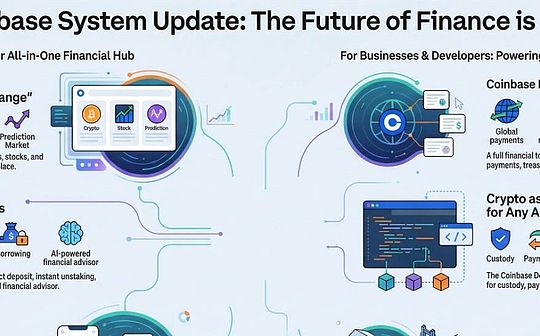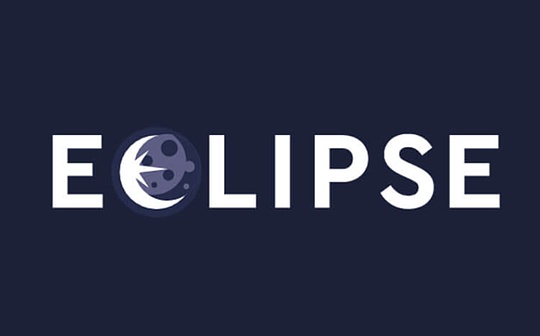
Author: YBB Capital Researcher AC-Core Source: Medium Translation: Shan Ouba, Bit Chain Vision
Eclipse background
Eclipse founder Neel Somani was the software engineer of Airbnb and a quantitative researcher at Citadel. In 2022, he founded Sorana -based startup Eclipse.The startup was supported by the co -founder of Solana, Anatoly Yakovenko and Polygon (architecture) and other institutions/individuals.Rollup blockchain is compatible with Polygon and Solana).According to the report of Coindesk on September 28, 2022, Eclipse successfully completed the $ 6 million seed round financing led by Polychain and the $ 9 million seed financing led by Tribe Capital and Tabiya, with a total financing of 15 million US dollars.In addition, Eclipse has also received development funding from the Solana Foundation to support Rollup driven by Solana virtual machine.
The founder Somani used his own network and the geographical advantage of the headquarters near Chicago, and successfully used Solana’s virtual machine to create a unique blockchain.His vision is to enable developers to deploy Rollups supported by Solana virtual machines, and plans to launch a public test network in the COSMOS ecosystem in early 2023 to support the MOVE language of APTOS in the future.
The co -founder of Solana and Eclipse angel investor Anatoly Yakovenko commented: “Eclipse paved the way for SOLANA to communicate with COSMOS through blockchain communication (IBC).”
Polychain Capital partner Niraj Pant said: “As large companies and governments begin to enter the blockchain field, Eclipse has become a key infrastructure that promotes its use cases, such as consumers and financial applications of Web2.”
Eclipse architecture
The following content is based on the official explanation: Eclipse Mainnet is the first general L2 centered on SVM, combining the nature of the modular stack. The goal is to become the fastest and most common Layer2 driven by SVM.The architecture of the project involves Ethereum as a settlement layer and a built -in official verification bridge; Celestia is used as a data availability layer; Risc Zero is used to generate zero -knowledge fraud proof; in the end, Solana’s SVM is the execution environment of this modular Layer2 project.The following explains in detail according to the official description.
Settlement layer -Ethereum: Eclipse will be settled on Ethereum (even if the Ethereum is used in Ethereum), use ETH for GAS consumption, and submit a fraud certificate on Ethereum;
Execution layer -Solana virtual machine (SVM): Eclipse will run high -performance SVM as its execution environment, especially the branch of the Solana Labs client (V1.17);
Data availability layer -CELESTIA: Eclipse publishes data to Celestia to achieve scalable data usability (DA);; DA);
Proof mechanism -Risc Zero: Eclipse will use RISC ZERO for ZK fraud certificate (not required to be serialized in the middle state);
Communication protocol -IBC: Eclipse will complete the bridge with the non -Eclipse chain through the COSMOS blockchain communication standard IBC;
Cross -chain Agreement -Hyperlane: Eclipse and Hyperlane cooperated to introduce Hyperlane’s unpredictable solutions into a blockchain based on Solana virtual machine (SVM).
>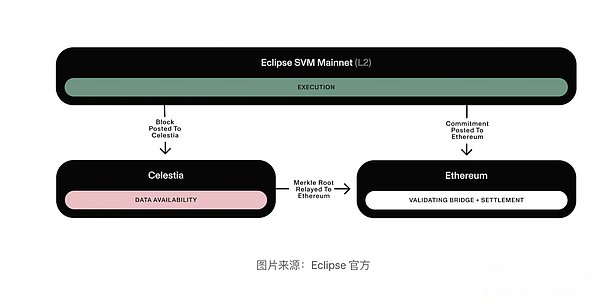
Settlement layer: get the safety and liquidity of Ethereum
Like other Ethereum Rollups, Eclipse uses Ethereum as its settlement layer.This process involves integrating the verification bridge of Eclipse directly into Eclipse. Among them, the node must check the correctness of the verification bridge and the correctness of the transaction order, thereby providing users with Ethereum level security.
L2Beat defines Layer2 as “a chain that obtains security from the first floor of Ethereum, so that users do not need to rely on the honesty of Layer2 verifications to ensure the security of their funds.”Final validity and anti -examination.Even if the sorter fails or starts on L2, the user can still enforce transactions through the bridge and use Ethereum as a transaction GAS.
Execution layer: Implement the speed and scale of Solana
In order to improve efficiency, the main network of Eclipse uses Solana’s execution environment, using SVM and Sealevel (Solana to build horizontally scalability technology solutions, a super -handed transaction processing engine that expands horizontally across GPUs and SSDs).Compared with EVM’s single -threaded operation, its advantage is that it can perform transactions without designing overlapping state transactions, rather than performing them in order.
In terms of EVM compatibility, the Eclipse main network cooperates with NEON EVM to allow developers to use the Ethereum tool and build a web3 application on Solana.According to official data, its throughput is significantly higher than the single -thread EVM, reaching 140 TPS.EVM users can interact with the Eclipse main network through the “SNAPS” plug -in through the Metamask wallet.
Data usability: Use Celestia’s bandwidth and verification
Eclipse 主网将利用Celestia 来实现数据可用性并建立长期合作,因为以太坊目前无法支持Eclipse 的目标吞吐量和成本,即使在EIP-4844 升级之后,每个块平均提供约0.375 MB 的Blob 空间(每The block limit is about 0.75 mB).
According to official data, for ERC-20 transactions based on ROLLUP expansion, it is calculated based on 154 bytes of each transaction, which is equivalent to all RollUPS for a total of about 213 TPS, and for compression Swaps, about 400 bytes per transaction, total TPS contractThe throughput of all rollups is about 82 TPS.In contrast, Celestia’s 2MB block, with the stability of the network and more DAS (data availability sampling) light nodes, Blobstream is expected to increase to 8MB.
Eclipse believes that with the support of Celestia DAS light nodes, Celestia has become the first choice for the current Eclipse main network.Although some views believe that the use of Ethereum DA is the orthodox method of Layer2, the project will continue to pay attention to the progress of the DA expansion after EIP-4844.If Ethereum can provide ECLIPSE with a larger and higher throughput DA, then the possibility of migrating to Ethereum DA will be re -evaluated.
Proof mechanism: RISC zero fraud certificate (no intermediate state serialization)
Eclipse’s proof method is similar to Anatoly’s SVM fraud proof of SIMD (see the extended GitHub link 2), which is consistent with John Adler to avoid the high -cost insights of status serialization.In order to prevent the Merkle tree from re -introduction of SVM, early attempts to insert the sparse Merkle tree into the SVM, but the Merkle tree will greatly affect performance every time.If the Merkle tree is used to prove it, the existing general Rollup framework (such as OP stack) cannot be used as the basis of SVM Rollup, and it needs more creative anti -error architecture.
Discovery requirements: The input commitment, transaction itself, and reorganization of the transaction will lead to different proofs from the specified output specified on the chain.
The input commitment is usually implemented by providing the Merkle root of the Rollow state tree.The actuator of Eclipse will publish the input and output list of each transaction (including the account hash value and the relevant global state), generate the transaction index of each input, and release the transaction to Celestia, allow any full node to follow up, fromIn its transaction, the state of the input account is extracted, calculated the output account, and confirmed that the commitment on Ethereum was correct.
There may be two main types of errors::
Incorrect output: The verification device provides a ZK proof of the correct output on the chain.Eclipse uses Risc Zero to create SVM execution ZK proof, and continues to prove the work of the BPF bytecode execution before the project (see the extended GitHub link 3).This allows our settlement contract to ensure correctness without having to run on the chain.
Entering error: Verifications publish historical data on the chain, indicating that the input state does not match the state of the statement.Then use the quantum gravitational bridge of Celastia to make the Eclipse settlement contract verify whether there is fraud historical data.
Eclipse and ETH and Celestia connections
>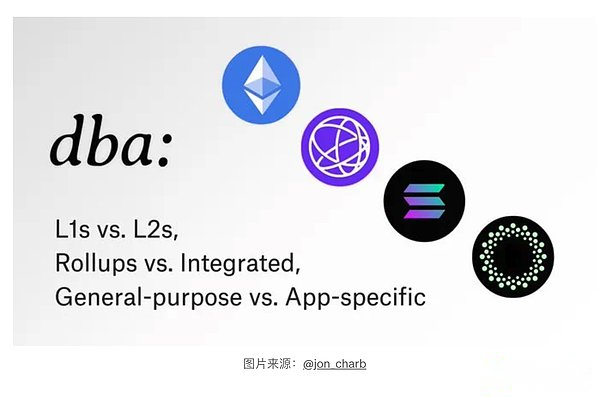
Data availability (DA) is one of the main components of rollup cost expenditure.At present, the availability of Ethereum L2 mainly depends on two methods: CALLDATA and DAC (Data Availability Committee).
· CALLDATA: For example, Layer2 solutions such as Arbitrum or Optimism make transaction data as CALLDATA directly on the block high anti -censorship block.Ethereum prices attribute data and computing and storage to one unit: GAS, which is one of the main costs generated by Ethereum Rollup.In order to improve efficiency, the EIP-4844 upgrades introduced Blobspace to replace CALLDATA, providing all Rollup with the target of 375 kb per block;
· DAC: Compared with publishing call data directly on the chain, DAC provides a higher throughput, but users need to trust a small committee or a set of verificationrs to avoid malicious detention data.DAC, including solutions based on heavy pledge, introduced important trust assumptions for L2, thereby forcing DAC to rely on reputation, governance mechanism or tokens voting to suppress or punish hidden data.Therefore, using external DA to some extent requires DAC.
It is worth noting that Eclipse uses Celestia’s Blobstream (a consensus network) to allow Layer2 to access Celestia’s Blobspace.According to the compression scheme, this can achieve a BLOB space of up to 8 MB, which is roughly equivalent to 9,000 to 30,000 ERC-20 transmission per second.However, Layer2 using Blobstream will depend on proof of Celestia verification device.If the light node detects 2/3 CELESTIA verifications, they can punish them.Objectively speaking, the credibility of DAC still has its deficiencies compared to the native chain DA, but from the perspective of innovation and market narrative, this shortcomings are inevitable.
>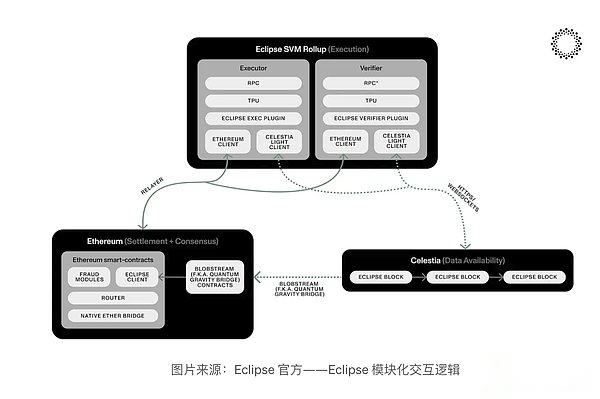
As explained in the official documentation and the above figure, Eclipse demonstrates the data proved to Ethereum by Celestia’s Blobstream (as mentioned above, Ethereum Da -based DA solutions).This enables bridges to verify the data security provided for fraud based on Celestia’s signature data root.The user deposits funds into Eclipse through the native Ethereum Bridge. The process is as follows:
1. User calls the Eclipse recharge bridge contract on Ethereum (contract address in expansion link 1);
2. Eclipse’s SVM actuator (calculating the SVM results and outputting to the new Eclipse status node) and the relay (ETH to the Eclipse channel) complete the cross -chain data interaction between the sender and the receiver address;
3. The relayr calls the SVM bridge connection program and is responsible for sending the user to the target address;
4. Requise to verify deposit transactions through the ZK-Light client (to be realized);
5. Finally, the trading block containing subsequent deposits is completed and published through the Solana Geyser plug -in.
In the process, each Eclipse Slot is published by the SVM actuator to the message queue through Geyser.These grooves are then published as data blocks to Celestia, and the Celestia verification device submits the submitted data blocks submitted to prove that the transaction is included in the Eclipse chain and corresponds to the data root.Finally, each CELESTIA data block is a contract with Blobstream to the Eclipse bridge on Ethereum.
>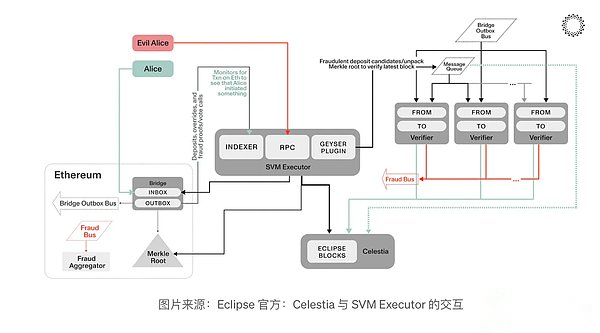
Similar to other Ethereum Layer2 solutions using fraud proof, it also takes a challenge period from ECLIPSE to withdraw funds to Ethereum, allowing verifications to submit fraud certification under the condition of invalid state conversion.
· SVM actuator regularly submits the Eclipse slot era (the process follows the batch of the scheduled quantity) on the Ethereum and releases the mortgage;
· Eclipse’s bridge receipt contract execution basic inspection to ensure the integrity of the published data format (see the fraudulent certification design part in the reference article [2]);
· If the submitted batches pass the basic inspection, a predetermined window will be generated.If in this window, the batch commitment indicates that the state conversion is invalid, and the verifier can issue a fraud certificate;
· If the verificationrs successfully issue a fraud certificate, they will win the mortgage of the executor, the submitted batches will be rejected, and the standard status of the Eclipse L2 will roll back to the last effective batch commitment.At this time, the administrator of Eclipse has the right to choose a new actuator;
· However, if there is no successful fraud certificate after the challenge period, the executor will recover its mortgage and rewards;
· Finally, the Eclipse bridge contract completed all the withdrawal transactions included in the final confirmation of the final confirmation of the batch.
Sum up
Eclipse is currently in the early stages of development and testing, marking the first SVM Layer2 on Ethereum.Its test network has been launched and is planned to launch the main network in the first quarter of 2024.Ethereum still regards Rollups as the core part of its development roadmap.Aside from the dispute over orthodox, this means that Ethereum defines the general definition of Layer2 to the market, and it is also cleverly introduced into various forms of competition.Eclipse uses this to combine the security of Ethereum, SOLANA’s high performance, and Celestia’s DA narrative through modular development to form a powerful market narrative.
Looking back at the development of Ethereum, an interesting phenomenon is the previous market cycle. Under the speculation of Defi Summer, the innovation and enhancement of “Defi nested” and “DEFI Lego” caused the explosive development of the ecosystem.This round of LSD and RE-STAKE combined, the combination of “pledged noodles” and “pledged Lego” surged, and Eigenlayer, Blast, and BTC’s Merlin’s Merlin raised rapidly in a short time.If nested and Lego are considered the main theme of market emotions, then modularization in the future can also play its unique nested and Lego melody.
The charm of modularity lies in the benefits of decoupled component, so as to achieve the innovation of each layer of the stack, and allow the optimization of each module to optimize the optimization of other modules.Perhaps in the future, the modular development process can provide developers and users with excessive competition options.


